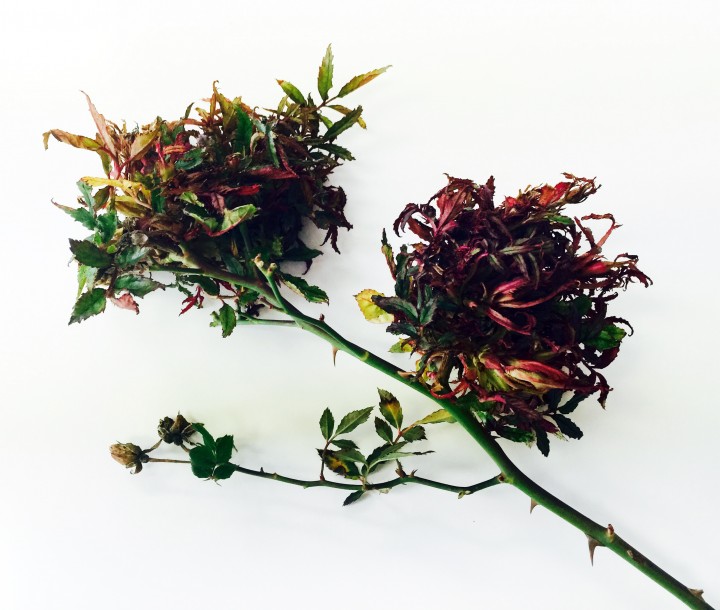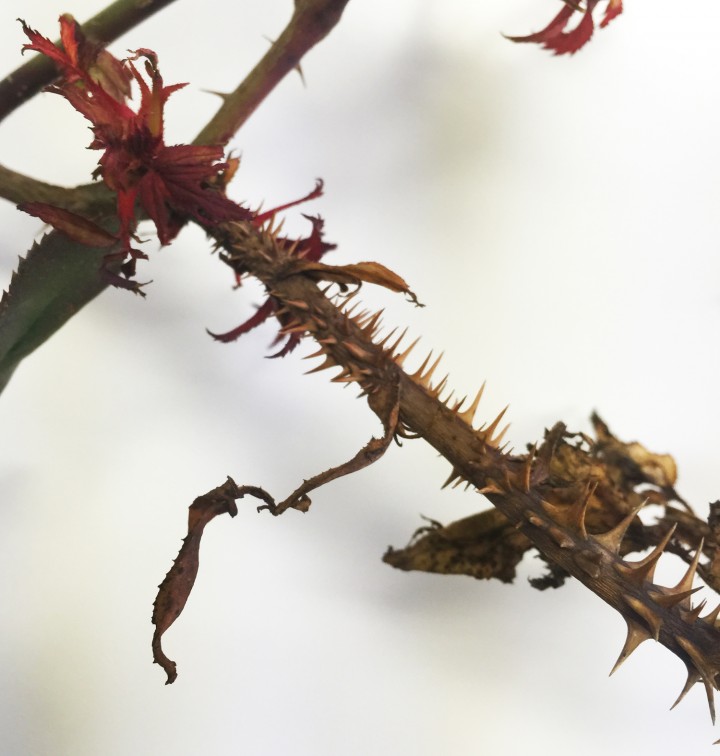Rose Rosette Disease
Rose Rosette Disease
How to identify and deal with this destructive disease.
Across the country, rose plants are dying from Rose Rosette Disease (RRD), also known as “witches broom”. If you have roses, you may have already heard of this destructive disease that will ultimately kill your roses. If this is the first time you’ve heard of Rose Rosette, be warned … if you have it in your landscape “There is no cure yet, and this disease is spreading like wildfire.” says Eric Taylor, Horticulture Manager of Roundtree Landscaping.
What is Rose Rosette Disease?
Rose Rosette is caused by a virus spread by a tiny Eriophyid mite named Phyllocoptes fructiphilus. The disease only affects plants of the genus Rosa, but it does affect all roses. There are no rose varieties that are resistant to the disease. Over the past year, we’ve seen a dramatic rise in the cases or RRD across the country. Because shrub roses like ‘Knock Out’ have been planted en masse, the disease has been able to spread to more plants at a fast rate.

Are Your Roses Infected with RRD?
How do you know if your roses have RRD? There are a few telltale signs. Your roses could have one or all of these symptoms:
- Overabundance of foliage, especially at the tops of branches, giving it the “witches broom” effect.
- Leaves and branches are bright red and are distorted or twisted.
- Excessive thorns along the stems that are also very bright red.
- Lack of winter hardiness.
Notice the extreme flush of foliage on this plant giving it the “witches broom” effect in the photo above. This is the most noticeable symptom of the disease. Of course, it is also the same symptom of broadleaf weed killer. However if you notice this symptom along with one of the other symptoms listed above, we highly recommend calling a professional to come check your plants. Remember, this is no cure for RRD and the mite spreads quickly.

Rose Rosette Disease takes about two years to kill your rose plant. The average lifespan for roses infected with RRD is 22 months. In this time, though, the mite will have most likely spread to your other roses, your neighbor’s roses and beyond.
Treatment Options
Unfortunately, there is no cure for RRD. Because the disease can take so much time to kill the plant, it’s common to think that certain treatments may have “cured” the plant. However, the best action you can take is to remove all infected plants, from the root system up. Infected root tissue left behind in the soil can sprout new infected shoots.
You’ll also need to remove any leaf litter and debris from the bed, as this is where the mites can take refuge. Don’t use a leaf blower to remove the leaf litter - remove it manually and bag it. Infected plants and leaves should not be added to the compost pile. Bag them up and put it in the trash to avoid spreading to other roses.
While some are experimenting with selective pruning techniques (cutting out infected shoots), there is no evidence yet that shows pruning is an effective treatment. Often, shoots that are infected may not show symptoms for many months. Also, the mites may still be on the plant and can spread RRD to new shoots. Therefore, pruning should not be considered a reliable treatment.
Can I Spray?
Unfortunately, most topical and systemic mite treatments available to homeowners are not effective for killing the mite that carries RRD. Also, the mites are very tiny and it can be difficult to know whether you’ve actually killed all the mites. If you have removed infected plants in your garden and have other roses that don’t yet appear to be infected, you can apply certain sprays through spring, such as horticultural oils and insecticidal soaps, to these plants as a possible preventative treatment.
I’ve Pulled My Roses: Now What?
Once roses infected with RRD have been removed from your landscape, it's tempting to plant new roses in the same spot right away. However, remember that tiny pieces of infected root tissue can sprout new infected shoots; which can then potentially reintroduce the virus to your landscape. It’s best to wait a year or two before planting new roses. We love roses, however there are many beautiful options to plant in their place. Also be on the lookout for RRD in your neighbor’s roses. If they are infected, it’s only a matter of time before your roses will become infected.
Slowing the spread of Rose Rosette Disease depends on all of us working together to spot the symptoms early and remove infected roses as quickly as possible. Print out the PDF below to share with neighbors, family and friends.
If you believe your roses show signs of Rose Rosette Disease, call us immediately to inspect and remove them if necessary.
